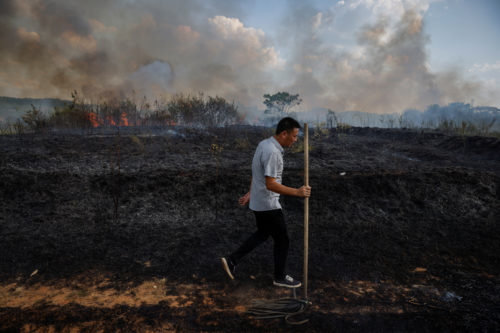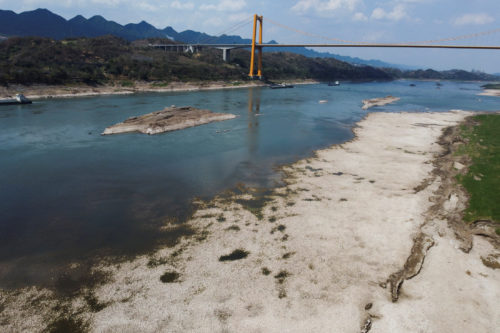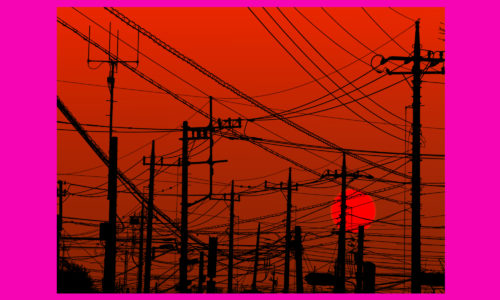China braces for another searing summer
Temperatures are already rising to unprecedented levels across China — and they're expected to get worse. Livestock, crops, and power grids are all expected to be affected. Will local governments be ready for the impact of these heat waves?

Summer is yet to officially arrive in the Northern Hemisphere, but an abnormally early heat wave has already taken hold in parts of China in recent weeks, with sweltering temperatures nearing or breaking seasonal records in dozens of cities and climatologists sounding dire warnings about extreme weather conditions in the next few months.
Since March, the mercury has been rising to unprecedented levels across vast swathes of the country. In April, temperatures in more than a dozen Chinese cities hit record seasonal highs, with Hangzhou, the capital of East China’s Zhejiang Province, giving locals an untimely glimpse of peak summer as it hit 35.1°C (95°F). Meanwhile, people in southwestern Yunnan Province, which is known for its mild weather, suffered a punishing spring heat wave that saw temperatures topping 40°C (104°F).
China news, weekly.
Sign up for The China Project’s weekly newsletter, our free roundup of the most important China stories.
The warm streak continued in May as weather stations at 446 sites across China registered temperatures that were the same as, or greater than, the highest ever recorded for the month. Shanghai reported its highest May temperature in over 100 years at 36.7°C (98°F), shattering the previous record by a full degree. A slew of major provinces and cities — including Shandong and Beijing — issued heat alerts, an unusual practice to occur ahead of the regular summer season.
As June came around, the blistering heat has shown no signs of letting up. The ferocious temperatures, which are currently affecting regions like Xinjiang and Guangdong, have been especially hard on the nearly 13 million students registered for the two-day gāokǎo 高考 college entrance exam this year, which started on Wednesday. For the rest of the month, most regions of China are forecasted to experience normal — meaning long-term average for the same period — or higher than normal temperatures, according to the China Meteorological Administration (CMA), the national weather service of the country.
The worst heat wave in Asian history
China is not the only Asian country trapped in a heat wave. Throughout April and May, an array of countries in Southeast Asia were in the grip of record-breaking temperatures that caused widespread hospitalizations, damaged roads, fires, and school closures. From Vietnam to Malaysia to the Philippines, governments in the area had to urge locals to stay home while trying to prevent major disruptions to agriculture and power generation in economies that were still recovering from the ravages of the COVID-19 pandemic.
The driving force behind what was described by some scientists as “the worst heat wave in Asian history” is El Niño, a naturally occurring weather pattern defined as an anomalous warming of sea-surface temperatures in the Pacific Ocean, Zhao Li, a Beijing-based senior researcher at Greenpeace East Asia, explained.
“The World Meteorological Organization has warned about higher possibilities of El Niño in summer or autumn this year,” she told The China Project. “It’s likely to be accompanied by more high temperatures and extreme weather events.”
The scorching heat also reflects a global trend of increasingly frequent episodes of extreme weather driven by climate change, Li added. In May, the United Nations warned that it is almost certain that 2023 to 2027 will be the warmest five-year period ever recorded due to human-driven greenhouse gas emissions and the combined effect of El Niño.
Livestock killed, crops damaged, and power grids stretched
The ongoing searing heat in China comes nearly a year after powerful convection weather wreaked havoc across the country. For more than 70 days straight, a brutal heat wave ravaged much of China in the summer of 2022, with sustained temperatures of more than 40°C (104°F). The persistent, extreme condition — which was unrivaled in China since the start of modern record-keeping in the country — ignited forest fires and dried up major bodies of water, with the Yangtze River severely impacted.
In order to ease a power shortage caused by a spike in demand for air-conditioning and depleted river water levels, which exacerbated the problem by reducing the amount of electricity produced at hydropower plants, local governments had to shut down factories and impose rolling blackouts.
In an ominous sign of what’s to come in the next few months, early ripple effects of the current heat wave have already emerged. In southern regions, electricity demand hit peak levels in late May, a month earlier than last year. As per state-run newspaper China Energy News, the State Grid Energy Research Institute predicted that the electricity supply situation would be tight across the entire nation this summer, with central, eastern, and southwestern provinces likely to experience shortages during periods of peak demand.
The weather has proven particularly dangerous to animals. According to local news reports, more than 5,000 pigs died overnight last week on a farm in Jiangsu Province after a sudden power outage caused cooling fans to stop working, which suffocated the animals to death amid extreme heat and poor air circulation. In Guangdong, reports of fish dying have been on the rise, prompting owners of aquaculture farms to adopt measures to cool off warm pools under the sweltering sun. As a result of last year’s two-month hot streak, which reportedly made rabbits less willing to mate and more prone to heat-driven death, the prices of rabbit heads, a popular delicacy particularly enjoyed by food lovers in Sichuan Province, have shot up.
A full-blown food security crisis concerning essential crops that humans rely on may also occur. In Henan, which normally produces around a third of China’s wheat, weeks of heavy rains in May caused a large amount of grain to go moldy or sprout too early, which often results in lower-quality flour unfit for consumption. Compared with 90% this time last year, Chinese media reported that only three-quarters of Henan’s crop had been harvested. To ensure that growing grain is still profitable for farmers, the central government has ordered state grain buyers to purchase lower-quality wheat at above-market prices.
On the other hand, because precipitation in the middle reaches of the Yangtze River — which provides more than two-thirds of China’s rice — is predicted to decrease markedly in the next few months, a resulting drought might severely affect rice production, as agriculture officials estimated.
How bad will it get and is China prepared?
While Li said it’s difficult to make a precise prediction about how hot China is going to get in the next few months, Chinese officials — perhaps learning from last year’s lesson — seem to have started working on response mechanisms in anticipation of a more fierce version of the ongoing heat wave.
At a press conference on June 2, a group of experts from the CMA urged local governments to ramp up their preparations in the face of high temperatures while providing a wide range of suggestions for those in agriculture, public health, and other related sectors. But because “there are many regions and departments involved, and they are facing different types of climate risks, it’s hard to check whether special measures have been taken this year than previous years,” Li said.
She emphasized that because the impacts of heat waves vary from area to area, authorities should design different measures tailored to specific needs. “For instance, in urban areas, the urban heat island effect is likely to amplify the extreme temperatures. In rural areas, heat waves are sometimes accompanied by droughts, which will pose a threat to agricultural production. In all regions affected by heat waves, the demand for energy for cooling is roaring,” she said. “If we are still depending heavily on fossil-fuel-based power plants, it’ll be a vicious cycle, as we’ll be using more energy for cooling and at the same time further heating up the climate.”
Li also pointed out that although a heat wave can affect anyone, those who are more susceptible to health risks due to their general physical conditions, such as the elderly and chronic disease patients, need extra caution and protection from the government. The vulnerable population also encompasses outdoor workers, who are often forced to labor in extreme temperatures in spite of the Administrative Measures on Heat Stroke Prevention, a policy document released in 2012 that requires employers to ensure safe working conditions, which include providing a high temperature allowance to employees working outdoors in temperatures above 35°C (95°F) and indoors in temperatures above 33°C (91°F).
“The implementation of the law, however, is lagging behind, and challenged by other complicated problems,” Li said, pointing to the practice of “flexible employment,” a nonstandard labor agreement widely used for workers employed in the gig economy, such as food delivery persons and temporary construction workers.






